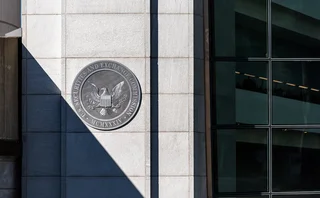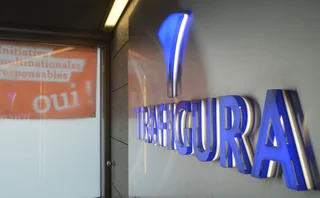
Looking back on 15 years
In many respects, the history of Risk magazine is the history of risk management. Risk’s founder, Peter Field, recalls some key moments in the magazine’s development
Since its launch in December 1987, Risk’s importance has grown more than any of us could have predicted. But then again, the world has changed beyond recognition. Back then, the worst you could imagine was losing all your money, as a lot of people did in the great October 1987 stock market crash. The horrific events of September 11, 2001, in a sense brought the concept of risk to millions of people who’d never thought seriously about it previously, and as all our readers will know, it had a devastating effect on Risk Waters Group. New lessons had to be learned within the financial and business sectors, and operational risk suddenly came into its own. Before September 2001, it was a sidebar to market and credit risk. Since then the disaster recovery and business continuity sectors have taken off.
When this magazine launched, concern about risk was largely confined to the insurance sector and a small but growing group of people in financial institutions. Risk management was a vague and poorly-grasped concept. Derivatives were in their infancy, exchange-traded contracts and over-the-counter swaps being the predominant examples.
There was actually an earlier attempt to sustain a magazine on derivatives, albeit one much more focused on the US and on exchanges. This was Intermarket, which flourished in 1985 and 1986 but went rapidly downhill to extinction soon after. I recall meeting Jim McNulty – now of course chief executive of the Chicago Mercantile Exchange – for the first time in Chicago in 1992. He was a senior man at Swiss Bank Corporation in that city, having moved over when SBC bought the private options powerhouse O’Connor Associates that year (the last of O’Connor’s 21 partners who joined SBC has just left the successor entity UBS. The first thing McNulty said when he came into the room was: “So you’re the man who helped put one of my investments out of business.” Apparently he was among a group of Chicago traders who had invested in the rival magazine.
Derivatives products and thinking about risk management developed fast as the markets recovered from the setback of October 1987 and tried to learn lessons from it. This rapid development created a tremendous air of excitement. New worlds opened up and new concepts and approaches were continually being tested. The community of practitioners and theorists was small, and everyone seemed to know everyone else. The close-knit nature of the industry was enhanced by a number of major team defections from one bank to another, as later entrants into the market tried to jump-start their business. For a long time ex-Citibankers dominated the swaps desks at other houses. The highest profile team defection was early in 1990, when Allen Wheat – later to be a controversial head of Credit Suisse First Boston until he was replaced by John Mack in mid-2000 – and 18 others left Bankers Trust to set up what became Credit Suisse Financial Products.
There were shortages of people but no dearth of ideas as firms rushed to develop new products. Risk played a key role in disseminating information about these products and how to price them. Of course, product development was the first stage of the market; learning how to risk-manage those products was to come later, after expensive mistakes had been made.
But for the first year or two of Risk’s life, I often felt we were fumbling our way through uncharted territory. When I launched the magazine, my initial concept was to cover what was happening in Chicago on the exchanges and what was being developed in the OTC market at firms such as Goldman Sachs and Bankers Trust. But my concept wasn’t that developed and the magazine’s editorial content changed quite a bit during the early issues. Even the basic terminology wasn’t settled in those early days. I heard the word ‘derivatives’ for the first time only shortly before I launched the magazine. During the rash of new products that emerged between 1988 and 1993, bankers would ring up Risk asking frantically for copies of articles on Asian options – or whatever the latest fad was – to be faxed to them because they were working on a deal. Others would ring for advice on where to obtain information. This was in the days when all of Risk’s small staff sat in two tiny offices and took turns to answer the phone. One day, I took a call from Citibank in Seoul looking for a source of historic Korean won/dollar option prices. I put in a few calls to brokers I knew in London and the puzzling consensus was that Citibank in London was the best place to try. I got through to someone on the options desk in Citibank who confirmed this and sounded very pleased with himself – until I told him who actually wanted the information.
Risk became the basic source of information on derivatives and risk management primarily because it asked practitioners and theorists to contribute articles that readers could actually use in their work. Rocket scientists became obligatory for any institution involved in the business. I remember meeting Fischer Black, the doyen of rocket scientists, for the first time in early 1987, before I launched Risk. I remember his charm and humility, which was helpful for me later when I asked him to write The holes in Black-Scholes article that appeared in the March 1988 issue. That article did as much as anything to put Risk on the map.
Rocket science
Black’s counterparts at other banks or in universities used the pages of the magazine to describe new products and theories in very technical terms, and by 1991 professor Mark Rubinstein and Eric Reiner were writing a whole series on exotic option products. Papers using both the Black-Scholes approach and the binomial tree approach proliferated. Trinomial and bushy trees also made their appearance in the pages of Risk. As Nicholas Dunbar pointed out in The Evolution of Quantitative Finance (Risk October 2001, page 102), computers didn’t have the power then that they do now. “As a result, quants favoured exact analytic solutions to option pricing problems (thus avoiding computers completely) and this involved the differential equation approach.”
After 1994 and the so-called derivatives disasters at Metallgesellschaft, Procter & Gamble and other companies, the focus of Risk’s technical articles shifted much more to risk management. Risk also published two seminal papers on smile models by Bruno Dupire and by Emanuel Derman and Iraj Kani. Others followed, inspired by the growth of equity derivatives where smiles and skews are particularly prevalent. Barrier options attracted a lot of attention at that time too. The first serious article on model risk appeared in 1996. More recently the emphasis has been on models based on stochastic volatility.
Naturally, value-at-risk also came into its own for a time starting in 1994, and there still seems plenty to write about it, though the emphasis now is more on defending the approach against its critics, especially over whether VAR models are mis-leading or not. But the main thrust of contributions to Risk over the most recent years has been on credit risk, interest in which exploded after the Asian meltdown and LTCM crisis in 1997 and 1998, and on the Basel II Accord. A large part of the debate about Basel has taken place in the pages of Risk. We published a paper in 1998 by Ugur Koyluoglu and Andrew Hickman, called Reconcilable Differences, which contained the formula that the Basel Committee eventually proposed for portfolio risk weightings.
First find your client
Both academics and authors of articles within banks found that publication in Risk often enhanced their careers or brought them consulting work. In the early days of Risk, one contributor wrote a very convincing article on a new type of option product that helped elevate him from a staid British merchant bank into a thrusting US investment bank. After about eight months, we rang him to ask how many deals had been done using the type of instrument he had so eloquently described in Risk. After some hesitation, he asked, “Do you want a round number?” “Yes,” he said. “Well, it really is round,” came the embarrassed answer. “Of course, we’ve put out several proposals and a lot of clients are interested....”
Risk had made its own stance clear as early as the February 1988 issue, when we ran a cover story First find Your Risk that warned that banks shouldn’t forget their clients in rushing to push new products. “Start with the identification of exposure,” the article urged.
Technology
We all know the product and risk management advances wouldn’t have been possible without corresponding technology advances. Nevertheless, the speed of evolution has been staggering when you bear in mind that as late as 1990 Fischer Black himself could write in Risk that he was “amazed that you could buy calculators with option formulae built in”; or that areas of quantitative research were being held back in the early 1990s by lack of computing power.
The early developments were software applications that confined themselves to pricing one product, and vendors operated in fixed-income, foreign exchange, equities or whatever to the exclusion of the others. Now, the ideal is much more comprehensive.
A couple of firms are coming close to that ideal – SunGard and Algorithmics. Even though the software community spawns start-ups faster than frogs and firms break up and multiply or get taken over, these two have been steady, consistent builders over the years, with SunGard the more acquisitive of the two. Cris Conde’s Devon Systems started advertising in Risk in 1988 as a modest start-up but soon started taking over other firms such as Infinity, Renaissance, Front, Bancware, Kronos and most recently Monis as it has grown into one of the biggest players worldwide across a whole range of financial and business sectors, not just in risk management or trading.
Over the years, demand for software has become much less product-driven and much more influenced by market, regulatory and competitive pressures. The ideal systems now would provide true enterprise-wide risk management, would cope with new concerns with credit risk and the Basel II Accord, would help with the fresh worries about operational risk and business continuity after September 11, 2001, would offer vastly improved data collection and distribution systems and would facilitate faster and smoother transactions via seamless straight-through processing.
The picture was a lot simpler in the late 1980s. Conde, Rod Beckström of C.ATS Software and Roger Lang of Infinity were frequent speakers on the conference circuit in the early years. In those days it was more common for the guys running the software houses to have high profiles and play a big promotional role – for the industry as much as for their own firms. Beckström and Lang were flamboyant Californians who’d initially set up together before going their own ways. Beckström later sold to Misys, Lang to SunGard. The last time Beckström appeared at a conference that I remember was in Amsterdam in 2000 after he’d sold out to Misys. He may have said something important, but all people remembered afterwards was his thanking the audience and their banks for making him rich enough to be able to spend all his time sailing in exotic locations.
Fending off the regulators
One of the other quite remarkable conclusions about 15 years in the risk management industry is how successful the industry has been in deflecting all attempts to regulate it. Go back to March 1992. You have the pesident of the Federal Reserve Bank of New York, Gerald Corrigan, questioning the suitability for clients of many off-balance-sheet products and telling bankers to take a “very, very hard look at off-balance-sheet activities”. To make his message clear, he added: “I hope this sounds like a warning because it is.”
Then in 1994 and 1995 you have a whole series of disasters such as Procter & Gamble, Orange County and Barings. You could argue til you were blue in the face that most of these so-called derivatives disasters weren’t about the mis-selling or mishandling of products, more about basic faults in management, but you couldn’t deny the outlook for derivatives was bleak then. If you read some of the articles in the American press or listened to some of the politicians, you would have a picture of derivatives as instruments devised by the Devil himself.
The hysteria about derivatives generated endless reports, mostly unflattering. Risk published a booklet in 1994, Fighting Fire with Facts, which Stephen Greene, then chief general counsel of Credit Suisse Financial Products, compiled from his reading of more than a dozen reports on the OTC derivatives markets and other reliable sources. He built a compelling case for not interfering with the markets. He claimed a “solid empirical foundation” to the case “that the OTC derivatives markets pose no special or unique risks requiring an immediate legislative response”.
Gradually, the furore died down. The industry itself addressed some of the more obvious problems, using the Group of Thirty report in July 1993 as a guide. The International Swap Dealers’ Association (now the International Swaps and Derivatives Association) stepped up its lobbying and its educational activities. There have been further major losses, such as those resulting from LTCM in 1998 (in particular UBS’s $693 million write-off) those in the sterling swaptions market in August 1999 and the hits from Argentina’s debt moratorium in December 2001, as well as further scandals, such as those surrounding the collapse of Enron, also in that month, but the markets have absorbed these shocks remarkably well. The US introduced FAS 133 in June 2000 and the leading central banks in January 2001 proposed the Basel II Accord, which probably won’t be implemented until 2007, but neither of these threatens the very existence of the derivatives markets in the way the proposals being bandied around in 1994–95 would have done.
On top of this, we have the change of heart of some former critics. Corrigan himself softened his line, perhaps because he joined the industry as an adviser to Goldman Sachs. When he spoke on derivatives risk and regulation at Risk ’95 in Boston, he was typically down to earth in his keynote speech, putting more emphasis on the importance of grey hairs in a dealing room than the latest models. I shall never forget his final words that ended the congress and baffled a number of delegates – their pens hovering over their notepads as they agonised over whether to record the phrase or not: “Remember, stuff happens.”
And at the top of the world’s most important central bank, officers wax positively lyrical about derivatives, in particular Alan Greenspan, chairman of the Federal Reserve. Just last month, Greenspan told the Council on Foreign Relations, in Washington, DC: “Conceptual advances in pricing options and other complex financial products, along with improvements in computer and telecommunications technologies, have significantly lowered the costs of, and expanded the opportunities for, hedging risks that were not readily deflected in earlier decades. These increasingly complex financial instruments have especially contributed, particularly over the past couple of stressful years, to the development of a far more flexible, efficient and resilient financial system than existed just a quarter-century ago.”
All kinds of risk
Most of the above subjects were covered in Risk, the features as well as the technical papers charting pretty closely the changes in the industry. There was a lot on new products in the early days, much more on risk management and the threat of new legislation in the US after the first big scandals emerged. Then came VAR and RiskMetrics and gradually the trend to managing risk on an enterprise-wide basis. Model risk came to the fore in 1996 and 1997 as the latter turned into the year of model losses. But after that credit risk took centre stage, along with the stunning growth of credit derivatives. Risk carried more supplements on credit risk in the late 1990s than on any other topic.
As the turn of the millennium approached, Risk began to carry more articles on Basel II and operational risk, the latter topic really coming into its own after September 2001.
Risk has also covered a lot of new areas of risk management such as environmental, weather, freight, lumber and emissions, as well as new strategies such as alternative risk transfer. It was enthusiastic about the prospects for bandwidth trading, influenced by the apparent success of Enron and other energy traders in promoting the market. But none of these new areas has really taken off. Jeff Skilling, Enron’s then chief executive, claimed in 2000 that the bandwidth market would be bigger than the interest rate derivatives market in five years. This claim had a nice ring about it for a time but looked less and less likely as the major telecommunications companies stayed out of the fledgling market (apart from Global Crossing and Cable & Wireless, and look what’s happened to them). Skilling also repeated the claim too often. The last time I heard him make it was at the Isda annual general meeting in Washington DC in April 2001, when he also astonished bankers and regulators in the audience and strained his credulity by starting and finishing his presentation with: “Buy Enron stock! It’s a steal at $54.”
Will the next 15 years see the same growth in risk management as the past 15? I doubt it, but there are still plenty of new users and applications to come into the market – smaller financial institutions in the developed centres, larger ones in the less developed ones, thousands of asset managers, thousands more corporations, many of whom still don’t routinely hedge simple risks such as currency, private wealth managers and family offices and eventually the general retail market. The ideas we have been writing about should now be relevant to a far wider audience.
| Best and worst |
| Sponsoring music has been one of the Risk hallmarks and provided some great moments. The highlights among Risk’s sponsorship programme were two concerts by Cecilia Bartoli at the Wigmore Hall in London; the International Chamber Music Season 1997-98 at the South Bank Centre in London; the Risk Publications series at the Wigmore Hall in 1998-99; and the Emerson String Quartet’s 25th anniversary concerts at the South Bank Centre in 2001. Risk Waters at the beginning of 2002 published a book on the history of the quartet written by the four Emersons and called Converging Lines. The Quartet very kindly allowed this to be sold on behalf of the Risk Waters World Trade Center Foundation. Risk also commissioned the American composer and Pulitzer prize-winner Charles Wuorinen to write a chamber symphony for performance by the London Sinfonietta. Cyclops (2001), as it was called, was premiered at the South Bank in May 2001. A CD of the work is to be released shortly. The worst moment in Risk’s short life was when the hijacked American Airlines jet rammed into the North Tower of the World Trade Center in New York on September 11 2001, killing everyone at the Waters conference on the 106th floor. The 16 staff the company lost that day and the 65 other people attending the event will always be remembered by their colleagues. |
Only users who have a paid subscription or are part of a corporate subscription are able to print or copy content.
To access these options, along with all other subscription benefits, please contact info@risk.net or view our subscription options here: http://subscriptions.risk.net/subscribe
You are currently unable to print this content. Please contact info@risk.net to find out more.
You are currently unable to copy this content. Please contact info@risk.net to find out more.
Copyright Infopro Digital Limited. All rights reserved.
As outlined in our terms and conditions, https://www.infopro-digital.com/terms-and-conditions/subscriptions/ (point 2.4), printing is limited to a single copy.
If you would like to purchase additional rights please email info@risk.net
Copyright Infopro Digital Limited. All rights reserved.
You may share this content using our article tools. As outlined in our terms and conditions, https://www.infopro-digital.com/terms-and-conditions/subscriptions/ (clause 2.4), an Authorised User may only make one copy of the materials for their own personal use. You must also comply with the restrictions in clause 2.5.
If you would like to purchase additional rights please email info@risk.net
More on Risk management
SEC leadership change puts Treasuries mandate under scrutiny
FICC clearing models approved, but critics think delay could revive prospects of done-away trading
Markets Technology Awards 2025: Untangling the knots
Vendors jockeying for position in this year’s MTAs, as banks and regulators take aim at counterparty blind spots
Risk Awards 2025: The winners
UBS claims top derivatives prize, lifetime award for Don Wilson, JP Morgan wins rates and credit
An AI-first approach to model risk management
Firms must define their AI risk appetite before trying to manage or model it, says Christophe Rougeaux
BofA sets its sights on US synthetic risk transfer market
New trading initiative has already notched at least three transactions
Op risk data: At Trafigura, a $1 billion miss in Mongolia
Also: Insurance cartels, Santander settlement and TSB’s “woeful” customer treatment. Data by ORX News
Cyber risk can be modelled like credit risk, says Richmond Fed
US supervisors may begin to use historical datasets to assess risk at banks and system-wide
The changing shape of risk
S&P Global Market Intelligence’s head of credit and risk solutions reveals how firms are adjusting their strategies and capabilities to embrace a more holistic view of risk







